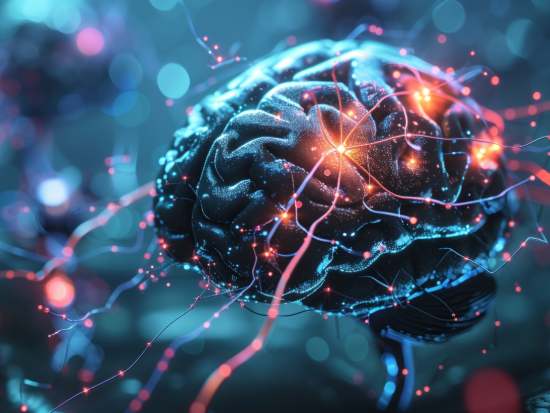 Deep Brain Stimulation (DBS) is an effective and safe treatment for motor symptoms in patients with movement disorders such as Parkinson’s disease. In addition to motor symptoms such as tremors, rigidity, and slowness of movement, communication deficits such as soft speech, using a monotone voice, mumbling, and difficulties with word-finding can affect individuals living with Parkinson’s disease and other movement disorders.
Deep Brain Stimulation (DBS) is an effective and safe treatment for motor symptoms in patients with movement disorders such as Parkinson’s disease. In addition to motor symptoms such as tremors, rigidity, and slowness of movement, communication deficits such as soft speech, using a monotone voice, mumbling, and difficulties with word-finding can affect individuals living with Parkinson’s disease and other movement disorders.
While ultimately regarded as safe, DBS can yield noticeable declines in verbal fluency, which affects how fast words can be retrieved and generated.
In a recent study published in the Annals of Neurology, UAB researchers in the Department of Neurology, Department of Neurosurgery, Department of Physical Therapy, and the School of Public Health discovered how unilateral brain stimulation impacts cognitive functions, including verbal fluency. Specifically, they found that right hemisphere stimulation over the course of the study did not yield declines in verbal fluency, compared to left hemisphere implants where verbal fluency declines were observed. The left hemisphere findings are consistent with the standard practice of bilateral DBS in people with Parkinson’s disease.
Bilateral vs. unilateral stimulation
Traditionally, DBS involves placing tiny wire electrodes bilaterally (on both sides of the brain) in patients with Parkinson’s disease. However, motor symptoms from Parkinson’s disease are asymmetric at onset, which means they affect one side of the brain more than the other.
According to Harrison Walker, M.D., of the UAB Department of Neurology, surgeons at UAB have been using unilateral stimulation on the most affected side of the brain for years as an alternative and less invasive option for DBS therapy.
“We have found that unilateral intervention substantially improves motor symptoms for years, with the option to proceed with DBS on the opposite side of the brain, if and when it is needed,” Walker said. “Despite this, little is known about how unilateral DBS impacts verbal fluency and other domains of cognitive function in these patients.”
Identifying the brain hemisphere linked to verbal fluency
In the study, researchers aimed to determine whether unilateral therapy on one side of the brain, specifically at the subthalamic nucleus, vs. the other side would allow for better maintenance of cognitive function in Parkinson’s disease patients. In addition to verbal fluency, the study looked at several aspects of cognitive function including memory and response inhibition, which is the ability to stop oneself quickly from completing an action.
Results showed that electrode implants in the left hemisphere of the brain appeared to be the primary cause of verbal fluency declines in patients who had undergone DBS surgery.
“Patients in our sample who received right-sided DBS implants actually showed mild improvements in verbal fluency function over the time interval of the study,” according to neuropsychologist Victor Del Bene, PhD., also of the UAB Department of Neurology. “While these mild improvements were unexpected, our results align with well-known ideas about hemispheric specialization of function in the human brain, where most language function typically resides in the left hemisphere.”
He added that similarly, left hemisphere stimulation was associated with greater declines in response inhibition, though there appeared to be no DBS-related hemisphere differences in terms of immediate or delayed recall of verbal information.
The results suggest that rather than stimulating both sides of the brain using DBS, unilateral right DBS may avoid DBS-related declines in verbal fluency and response inhibition in patients with movement disorders like Parkinson’s disease.
“We hope that these results may convince neurologists and neurosurgeons at other medical centers that unilateral DBS on the most affected side of the brain is a viable therapeutic option, with potential advantages over the more invasive bilateral option for therapy,” Walker said. “In particular, unilateral right hemisphere stimulation might spare occasional declines in some aspects of cognitive function that accompany the bilateral DBS intervention.”
A collaborative effort
 Victor Del Bene, Ph.D., and Harrison Walker, M.D., UAB Department of NeurologyThe results of this study are from a nearly $6 million NIH BRAIN Initiative grant (UH3-NS100553). The researchers plan to expand on these results with a new BRAIN Initiative grant obtained by Walker and his team.
Victor Del Bene, Ph.D., and Harrison Walker, M.D., UAB Department of NeurologyThe results of this study are from a nearly $6 million NIH BRAIN Initiative grant (UH3-NS100553). The researchers plan to expand on these results with a new BRAIN Initiative grant obtained by Walker and his team.
Walker and Del Bene agree that “an important mission of an academic medical center like UAB is to advance knowledge on how treatments impact the lives and daily function, including cognitive symptoms, in patients with movement disorders. We are especially indebted to the patient volunteers, research team, and clinical staff who collaborated over the five years of clinical care, data collection, and data analysis for this project. Without everyone’s involvement, these efforts would not have been possible.”
Other authors are Roy C. Martin, Sarah A. Brinkerhoff, Joseph W. Olson, Dario Marotta, Christopher L. Gonzalez, Melissa Wade, and Frank G. Robinson, UAB Department of Neurology; Matthew J. Nelson, J. Nicole Bentley, and Barton L. Guthrie, UAB Department of Neurosurgery; Gary Cutter, UAB School of Public Health; Chris P. Hurt, UAB Department of Physical Therapy; Kelly A. Mills and Vidyulata Kamath, Johns Hopkins School of Medicine; Robert T. Knight, University of California, Berkeley.
Support came from the National Institutes of Health BRAIN Initiative, UH3-NS100553.